In Japanese folklore a Tiger that lives to be 500 years of age turns white and transforms into a powerful Yokai spirit animal – the Byakko, the Celestial Tiger of the West with the power to direct both tempestuous wind and beasts to its will. This Katana from Balaur Arms takes its martial inspiration from the tiger, an example to all warriors for its perfect and peerless match of speed, grace, sheer muscled power and unflinching fierceness – a mirror for the Samurai spirit. Legendary actor Toshiro Mifune would take inspiration from the Tiger for his predator-like movements coupled with an unblinking, threatening stare to create an air of tense danger when playing a skilled Samurai or Ronin.
Like its Tiger namesake, a strike from a sword such as this is both a swift and decisive blow that commands finality to mortality. The fittings of this katana ably walk that line between ornamentation that demands professional respect and the practical materials and components needed for a Samurai’s sword of war.
The blade is forged from tough T10 high carbon steel which has been clay tempered in the traditional manner, as can be seen in its vibrant and genuine hamon in the Togari style. The blade was painstakingly polished to a mirror sheen to fully bring out the beauty of the steel and the rippling hamon of a hardened, wear-resistant steel edge. The blade edge has “Niku” shaping behind it to ensure that it is more durable and resistant to chipping and damage than a flat edge. The blade has no bohi groove to ensure that it strikes with the additional mass needed to deliver maximum force to the cut. Such swords were popular in times of war when a durable and hard-hitting blade was desired for battle against opponents wearing thick cloth and armor. Additionally, the blade has a genuine geometric Yokote style tip – not only is this feature more authentic to historical katana, its wedge-shaped geometric planes serve to reinforce the tip for thrusting and puncturing into the weaker points of an opponent’s armored defense. This is feature that is often overlooked in many other katana which instead simulate this feature using differential polishing.
The blade has been set into a hilt that has a tsuba of practical and robust stainless steel with an antiqued iron finish bearing the visage of the stalking Tiger on one side and its prey upon the other. Its fuchi collar and kashira pommel are likewise of antiqued stainless steel. The habaki is cast from detailed brass and offset with seppa of red copper. The hardwood tsuka grip has panels of genuine rayskin which are bound in a practical and tight Katate-Maki “Battle Wrap” of artificial silk tsuka ito which is finished with a pair of brass Tiger menuki beneath the folds.
The sword is paired with a scabbard of well-carved wood which is finished with a textured lacquer that is more resistant to scuffs and scratches than the high gloss lacquer seen on many other katana. Koiguchi, Kurigata and Kojiri components are crafted from genuine and finely polished buffalo horn and they serve their purpose of helping to prevent the saya scabbard from splitting at its seam. The sageo cord is of matching silk and a cloth katana bag for storage or transport is included.
Please Note: In the Video section you can a cutting demonstration with this Katana, including an impressive double-cut through a double roll of thick tatami!
Please Note: Like many other production Katana, some small or light scuffs or scratches may be present on the blade and the orange-yellow color of the lacquered rattan binding may vary slightly from the photo


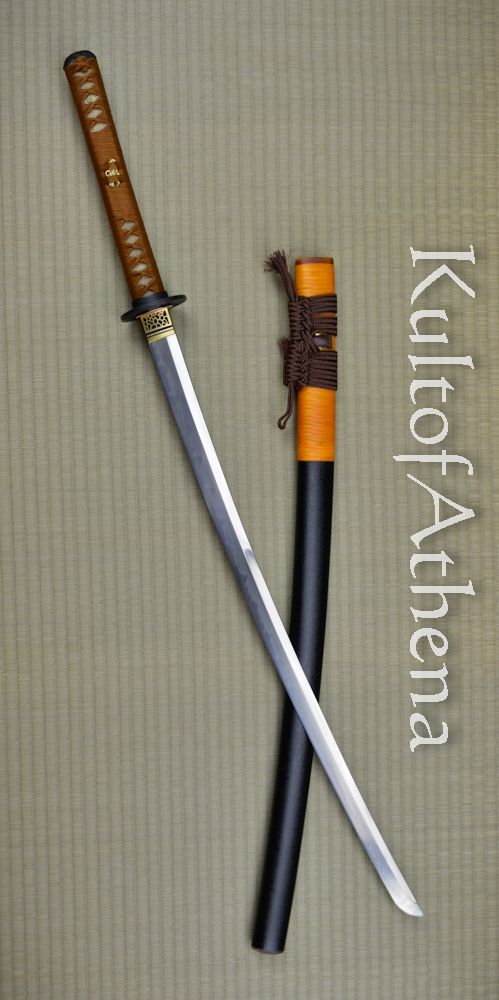
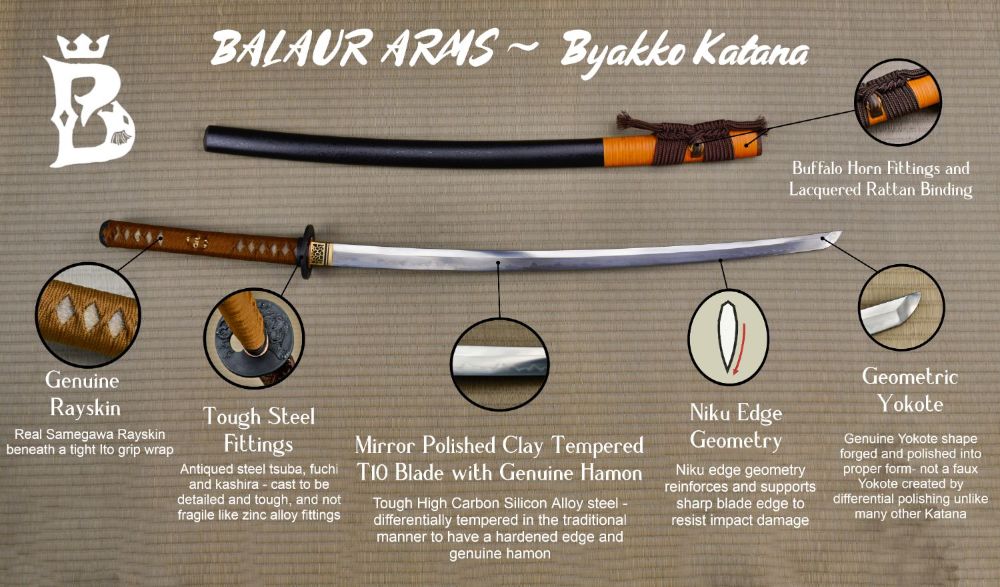

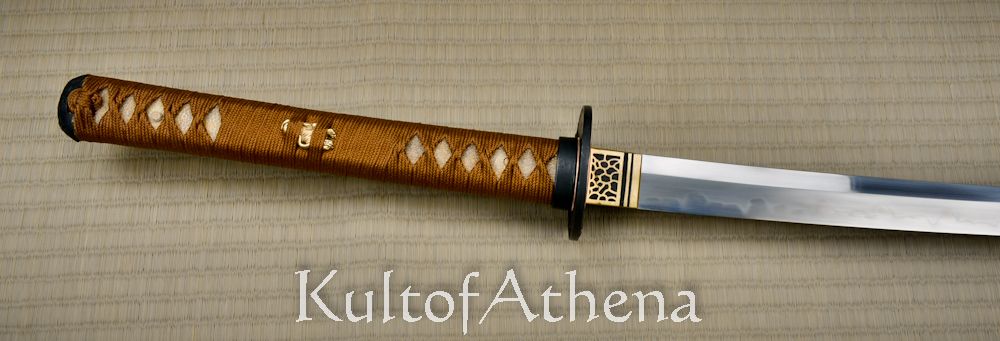

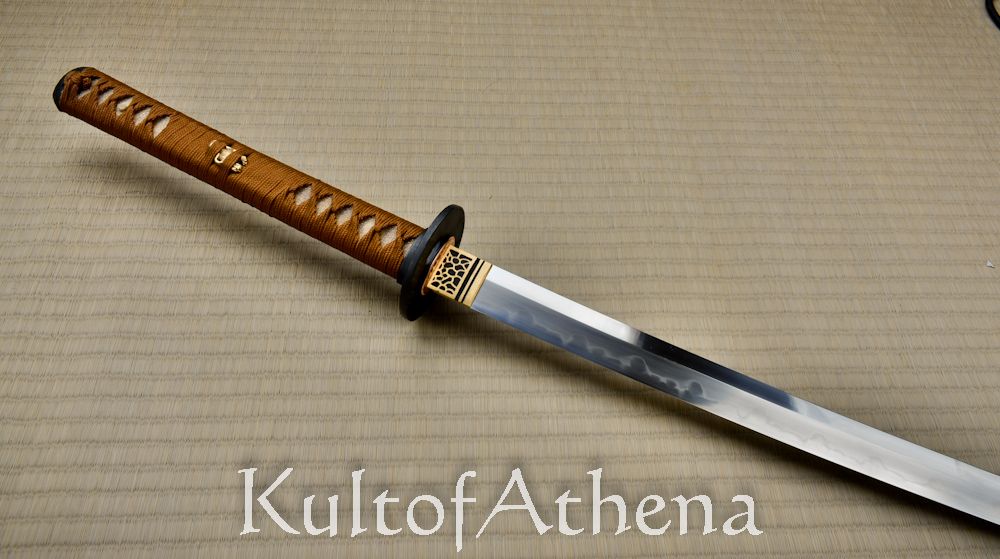
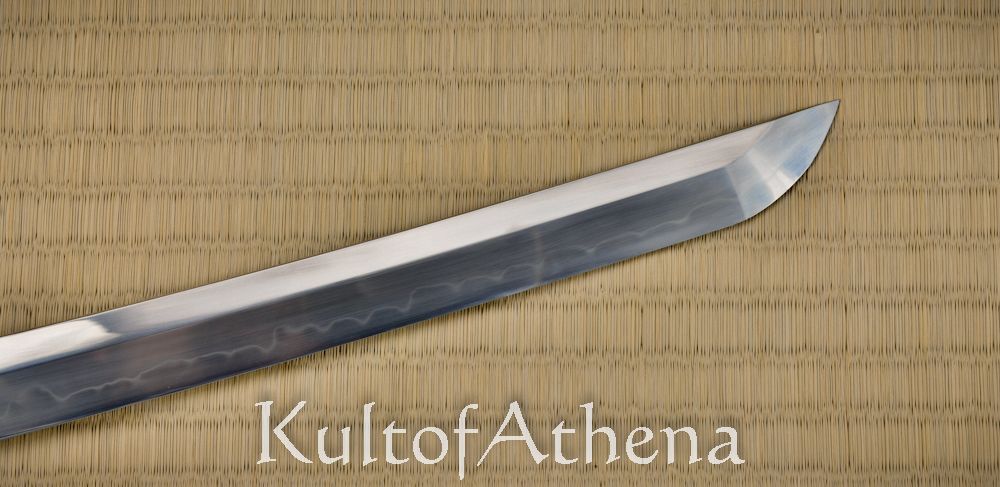
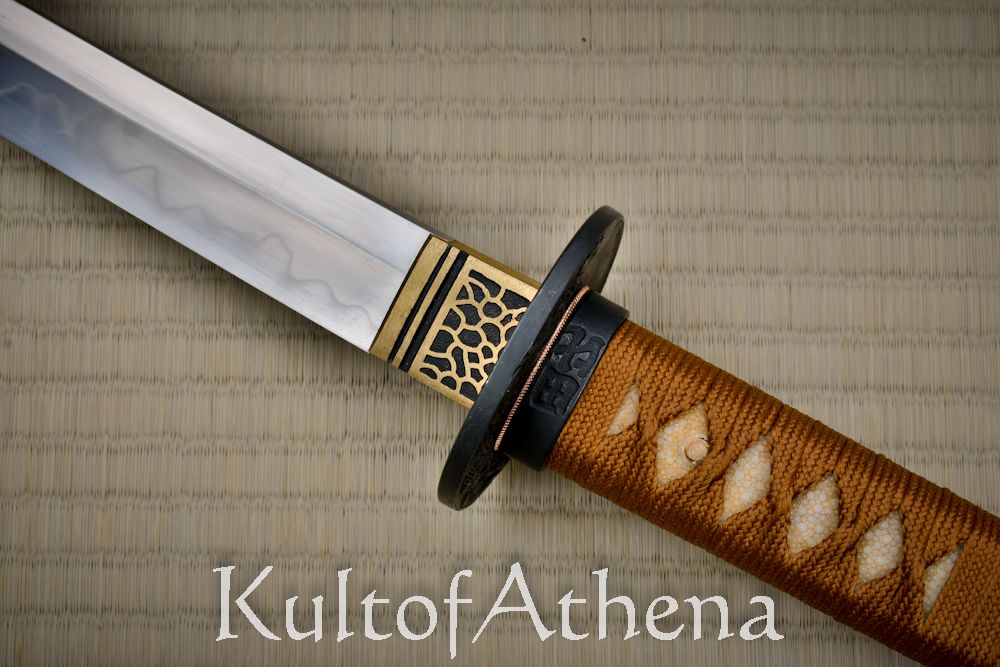
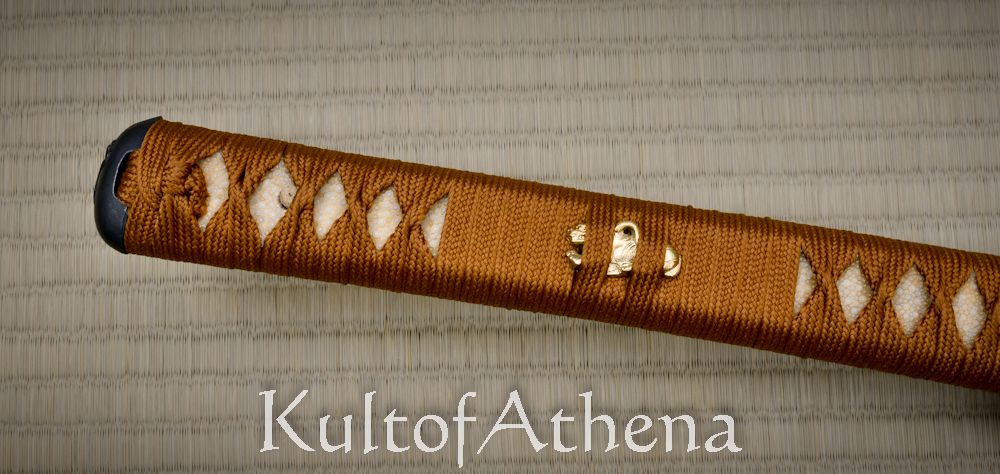
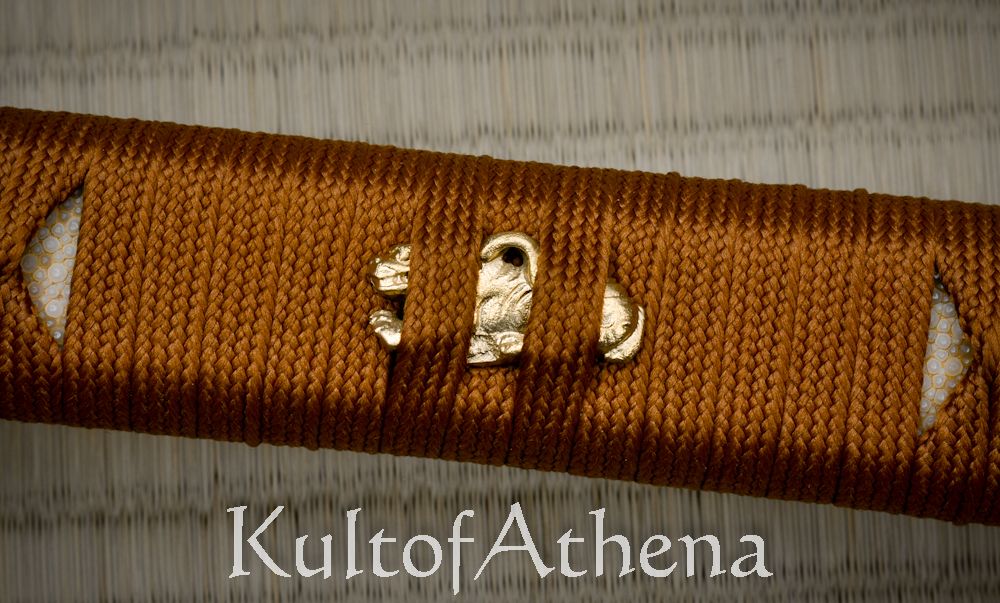

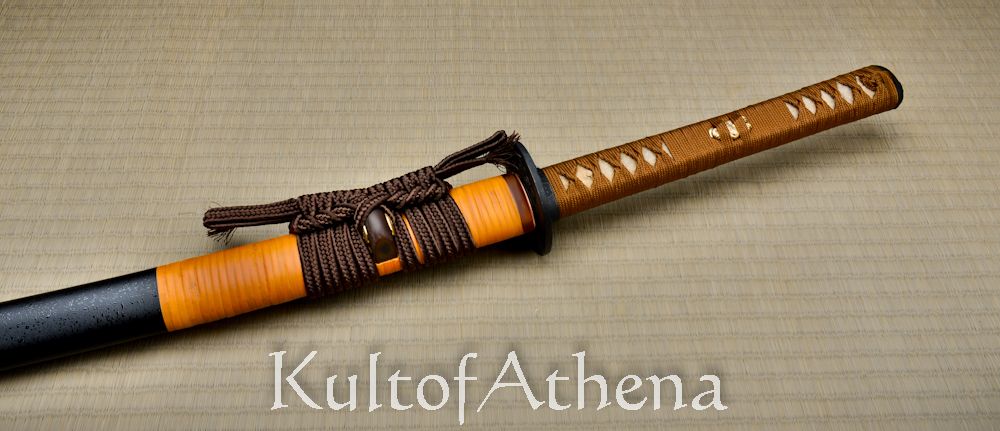

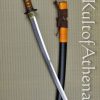



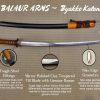
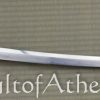
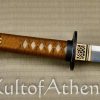
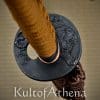
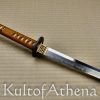
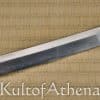
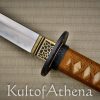
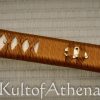
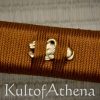
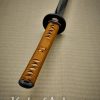
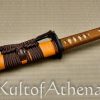
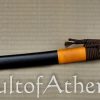
Aikidoka –
I was VERY impressed with the cutting performance of this blade. The weight and balance enable quick and powerful cuts, and the edge geometry allowed for cuts through double tatami mats with ease. My only recommendation to the manufacturer is to reduce the ledge that exists between the fuchi and ito. I wouldn’t hesitate to recommend this sword, especially considering the price!
ray d blundell (verified owner) –
I ordered mine on the 4th once it was mailed got here in for days which was today.This is a inspection review because this is a christanas present.Frist the Tsuka has some curve to it, the tuska-ito tsukamaki is tight enough could be little tighter,really like the battle wrap and color of it.The keshira looks good but ther is a gap between the tuska-ito tsukamaki and the keshira at each end of the keshira.The same gawa-ray skin appears to be panels,with small nodes.The menuki are in place tight and look good. The mekugi are placed well.i Really like the copper sepa,they fit nicelly against the tsuba.Allso really like the design of the habaki.The blade has heaft to but moves well,the hamon is done very well.,also can cut hair on my arm with the blade-sharp.Also the fuchi is nise but little gap at top and bottom where meets the tuska-ito tsukamaki.The says has bamboo wrap by the sageo which looks nice.The shito dome are well done,the koraigata, koiguchi,and the kojiri all bull horn.The saya it a matted black finish ti it.Also like the design on the tsuba.All in all I think this is a great katana,can’t comment on the cutting ability do to it is a christamas when get a chance to cut with it will make a update.araember to only cut water bottles mats and bamboo ,safe cutting Ray Blundell
Ray Blundell (verified owner) –
Up date on cutting mats,can,t say enough on the quality of it,s mat cutting just great Ray Blundell
e.mcreynolds (verified owner) –
An attractive and powerful cutter. The only issue that I had was with the kashira. It had a spur which extended above the ito by more than a sixteenth of an inch. I was able to file this down to an acceptable shape. If you must do this, note that the fitting is cast stainless and will require something like Jax blackener to retouch it.
ColdSteal (verified owner) –
Nice Blade. The kashira was not secured by a properly wrapped ito nor was it reinforced with any glue and it slid off after one non cutting practice session. After inspecting I find that one side of the wood nodules exposed from the kashira coming off has oddly cracked/chipped wood (was not damaged by me, it simply slipped off) that is definitely a quality control issue. I used gorilla wood/metal epoxy to re-secure the kashira and I made some unsightly knots and burned the ends of the ito. I will likely have to buy a replacement tsuka down the road, probably much sooner than I would like. I will be sending KOA/Balaur pictures and see what they think. My first katana and it is beautiful, I look forward to learning bokudo and other ancient arts with it.